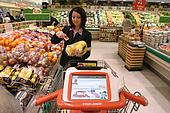What’s all this carbohydrate and glycemic index stuff about?
Continue reading to discover why it’s important to eat carbohydrates responsibly.
Well, the first thing to consider is carbohydrates are broken down into glucose easily in the body. Fat and protein convert more slowly. Carbohydrates are our body’s best source of glucose for energy. Without it our brain, muscles and cells would die.
However, too much is unhealthy. Extra glucose is stored in our liver and muscles. The body likes to maintain a steady glucose level, so stored glucose or (glycogen) is released by the liver to keep levels in check. Our brain uses a quarter of the glucose to function even when sleeping. Our muscles store two thirds for movement. The liver stores only a third to maintain proper blood sugar levels.
There are millions of overweight, under exercised people, eating loads of processed foods out there. The quick change in blood sugar levels, these people might experience, can lead to weight gain, diabetes, heart disease, or low blood sugar. They have eaten too much of a good thing.
Learn About the Consequences of a Poor Unbalanced Diet
 Sydney University’s web site imparts interesting facts on glycemic food values, and contains a glycemic index list of foods to help you prevent problems before they happen. They explain how eating refined sugar or refined flour can cause sugar levels to go up fast, peak, and then quickly fall, because these foods have a high index. Meaning, they change quickly from a carbohydrate into glucose within the body. Having a list of food indexes helps us make better food choices.
Sydney University’s web site imparts interesting facts on glycemic food values, and contains a glycemic index list of foods to help you prevent problems before they happen. They explain how eating refined sugar or refined flour can cause sugar levels to go up fast, peak, and then quickly fall, because these foods have a high index. Meaning, they change quickly from a carbohydrate into glucose within the body. Having a list of food indexes helps us make better food choices.
Glucose levels can fall fast when our pancreas pumps insulin into our system telling cells to mop up all the glucose, when sugar levels spike. Cells, after being bombarded in this way, may become resistant to insulin’s signal and become starved for what they need. This makes a person tired and hungry for more carbohydrates.
Our body now has excess glucose to make a hormone releasing fat which tells cells to ignore insulin. The higher our insulin goes the fatter we get with adipose fat, which we deposit around our organs and belly. We are tired, fatter, and less likely to be physically active. This forms a continuing cycle.
Things could get worse. If the pancreas pumps lots of insulin, the blood sugar can drop so low insulin shock occurs and consciousness is lost. The liver runs out of glucose, can’t raise blood sugar to a normal level, and cells have stopped listening to insulin’s signal. Diabetics carry hard candy with them for this reason. It pays to have a balanced diet.
What is a Normal Level of Blood Sugar?
 Karlene Karst, RD, in her book entitled, “The Metabolic Syndrome Program,” claims normal blood sugar would be between 70mg/dl and 110mg/dl. After a fasting glucose test a level below 70mg/dl would indicate hypoglycemia or low blood sugar. Impaired glucose tolerance would be present with a reading of 110mg/dl after eating 2-3 hrs before. Two tested measurements above 200mg/dl indicate diabetes. Check with your doctor for more specific information on normal range blood sugar levels.
Karlene Karst, RD, in her book entitled, “The Metabolic Syndrome Program,” claims normal blood sugar would be between 70mg/dl and 110mg/dl. After a fasting glucose test a level below 70mg/dl would indicate hypoglycemia or low blood sugar. Impaired glucose tolerance would be present with a reading of 110mg/dl after eating 2-3 hrs before. Two tested measurements above 200mg/dl indicate diabetes. Check with your doctor for more specific information on normal range blood sugar levels.
Keep your blood sugar level so the pancreas doesn’t become overworked. Eat the right kinds of carbohydrates, fat, and protein, and you can shed excess weight and prevent insulin resistance and diabetes. Also, remember not to vilify carbohydrates, because we need them to survive. All carbohydrates are not the same. The most common carbohydrates are from fiber, starch, or sugar. Always remember, the glycemic index ranks carbohydrates according to the effect they have on sugar levels.
High Fiber Low Glycemic Foods are Good for You
 Fiber is a good carbohydrate which converts slowly in the body helping to stabilize blood sugar. People with a high fiber diet experience less gastrointestinal diseases, heart problems, and constipation. According to the Institute of Medicine, men under 50 should eat 38 grams of fiber each day. Women need to consume 25 grams per day. Few people in the U. S. get even close to the recommended amount.
Fiber is a good carbohydrate which converts slowly in the body helping to stabilize blood sugar. People with a high fiber diet experience less gastrointestinal diseases, heart problems, and constipation. According to the Institute of Medicine, men under 50 should eat 38 grams of fiber each day. Women need to consume 25 grams per day. Few people in the U. S. get even close to the recommended amount.
Soluble fiber is soluble in water, sources include: barley, flax, legumes, some vegetables and fruits. Soluble fiber acts like a sponge, binds toxins, and can help lower cholesterol and blood sugar. Insoluble fiber doesn’t break down and cleanses the colon as it passes out, lessening constipation, and producing a feeling of fullness. Flax seed, whole grains, wheat bran, and some fruits and vegetables contain insoluble fiber and are on the low glycemic food list.
The Glycemic Index isn’t perfect but it’s a Place to Start
Many things affect the index of a food, for example a ripe banana has a GI of 74, and a green banana has an index of 43. Particle size matters. Whole grain has a lower GI than flour. Preparation can change the GI. Also, we each react differently to foods. For more information check out the book “The New Glucose Revolution: The Authoritative Guide to the Glycemic Index-the Dietary Solution for Lifelong Health,” by Dr. Jennie Brand-Miller and et al.
For example sugar and simple starches raise blood sugar fast. While, other carbohydrates like fiber break down slow and release gradually into the blood, also the amount of food eaten matters. The Glycemic Load takes this difference into account. To calculate the load take the Glycemic Index and divide it by 100 times the total carbohydrates minus the dietary fiber.
Just concentrating on carbohydrates would be a mistake. Eating protein with each meal and taking in fats from a variety of sources other than saturated fat balances the diet. Consider eating more omega 3 fatty acids from fish or flax, most of us don’t get enough.
Take charge of your health today. Find out more about the glycemic value and load of foods. Don’t make it complicated; mix a high GI food with a low one to make a medium one. Eat less sugar and starch. Stay away from fructose corn syrup, and use a natural sweetener like Stevia. Eat whole grains, fruit, and vegetables, instead of heavily processed foods. For handy glycemic index charts and lists to help make your shopping easier consider buying Jennie Brand-Miller’s book mentioned above.




